|
FORT SUMTER National Monument |
 |

"The Flag of Sumter, October 20, 1863" painted by
Conrad Wise Chapman, Confederate artist.
Courtesy Confederate
Museum, Richmond.
The Small-boat
Assault
On the night of September 8—9, 400 sailors and marines made the attempt. A tug towed the small boats within 800 yards of the fort, then, too awkwardly, cast them loose. In the darkness and confusion, plans went awry. Without the benefit of a diversionary assault, two columns advanced simultaneously upon the right flank of the fort.
The Confederate garrison coolly held fire till the leading boats were in the act of landing, then let loose with a galling fire of musketry, hand grenades, "fire balls," grape and canister, brickbats, and masonry fragments. At a signal from the fort, the Confederate gunboat Chicora steamed out from the harbor and opened fire; Fort Moultrie "fired like a devil."
From the outer boats, the marines replied rapidly for a few minutes. Some of the sailors ashore fired a few times from their revolvers, but for the most part sought refuge in the embrasures or breaches of the wall. It was all over in 20 minutes. Most of the boats did not even touch shore. The Federal loss was 124 killed, wounded, and captured; 5 boats were taken. A similar expedition from Gillmore's command was detained by low tide in a creek west of Morris Island. Service rivalry had prevented active cooperation that might have meant victory.
For 19 days following the small-boat assault, Fort Sumter was free of attack; then, after a 6-day bombardment of "minor" proportions, for 23 days more. Damages sustained by the monitors in the Morris Island operation, as much as fear of channel obstructions (a menace afterwards proved greatly exaggerated) and Fort Moultrie's evidently increased fire power, made Admiral Dahlgren reluctant to make another move at this time. General Gillmore, engaged now in rebuilding and rearming the captured Confederate batteries on Cummings Point, thought he had accomplished his part of the operation. In his opinion, Fort Sumter was effectively reduced; its seizure and occupation would be a costly and unnecessary operation. Further offensive operations by his force had never been contemplated; and the reenforcements needed for such operations were not to be had. Indeed, with the "turn of the tide" at Vicksburg and Gettysburg, Charleston had suddenly become much less important.
Meanwhile, Fort Sumter's garrison was not idle. It was at this time that the great "central bombproof" with quarters for 100 men, was built out from the gorge interior and, in the remaining casemates of the right face, a new 3-gun battery mounted.

|
|
Last Modified: Mon, Dec 2 2002 10:00:00 am PDT |


